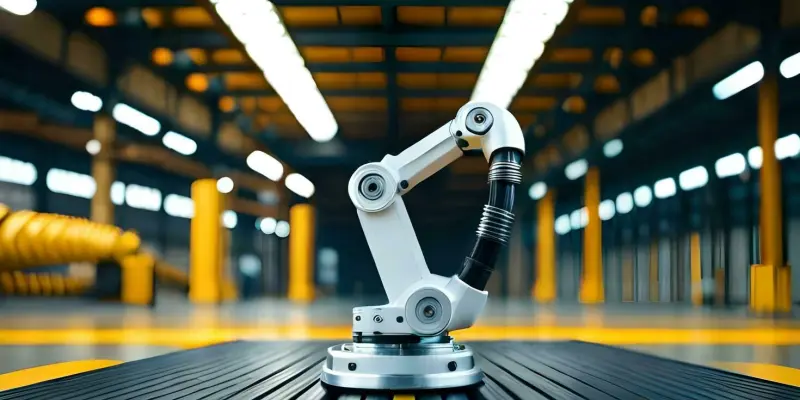In the ever-evolving landscape of robotic technology, significant innovations are reshaping how industries operate, bringing forth greater efficiency and precision. A noteworthy advancement is the introduction of Güdel’s 7th-axis linear track enhancements, notably the Cobomover, which symbolizes a leap forward in collaborative robotics. Debuting at Automate in Detroit this year, Güdel’s solutions are garnering interest for their ability to extend the operational capacity of both collaborative and lightweight industrial robots. This additional mobility turns into practical advantages, as the extended range provided by the 7th axis can lead to improved efficacy in storage and retrieval systems. By offering up to 5 meters of extra working distance, this technology meets the demands for increased productivity in various industrial scenarios.
Innovative Features and Capabilities of the Cobomover
Expanding Robotic Horizons
The Cobomover, one of Güdel’s standout innovations, enhances the flexibility and application potential of robots with its uniquely integrated 7th-axis linear track. It achieves this by incorporating a sliding mechanism that extends the robot’s range of motion beyond traditional limits. Such a feature is particularly valuable in settings requiring enhanced reach, such as logistics, manufacturing, and complex assembly lines. With the ability to travel up to 5 meters, this additional freedom supports robots in covering wider workspaces seamlessly, reducing the need for multiple stationary units and thus streamlining operations. The Cobomover’s adaptability extends across different sectors, including material handling and packaging, offering a compelling solution for industries looking to maximize productivity.
Versatile Integration and Performance
Beyond its impressive reach, the Cobomover showcases exceptional compatibility with over 60 different robot manufacturers. This wide-ranging compatibility allows for seamless integration into existing production lines, ensuring minimal disruption and added value. Furthermore, the device supports versatile mounting options, whether at 0° or 180°, catering to varied operational needs. With a maximum payload capacity of 78 kg, a speed of 2 meters per second, and capable of accelerating at 2 meters per square second, it delivers high-performance capabilities. The promise of repeatability within ±0.05 mm highlights its application for precision-dependent tasks. These specifications enable the Cobomover to meet diverse industrial requirements, showcasing its potential to enhance multifaceted processes.
Advancements in Heavy-Duty Applications
TMF-4B: A Game-Changer for Heavy Payloads
Güdel’s innovative spirit continues with the development of the TMF-4B track, an embodiment of cutting-edge engineering aimed at addressing challenges in heavy-duty robotic applications. This track is specially equipped with air bearings, a feature that significantly minimizes friction, allowing for smoother operation. By using only 5 psi of air to elevate the track off the ground, heavy robots can maneuver with greater fluidity. Initially designed for painting operations in the aircraft industry, the TMF-4B track is adaptable for the automotive sector as well. This adaptability speaks to its robustness and versatility, offering industries a reliable solution to manage high payloads while ensuring precision and consistency in challenging environments.
Enhanced Functionality and Industrial Reach
The benefits of the TMF-4B track extend into a variety of complex applications, making it an invaluable asset in sectors that demand both finesse and strength. Capable of supporting painting and welding processes, it ensures that robots operate at optimal efficacy without the wear and tear associated with friction. This technology serves as a strategic advantage, especially in automotive manufacturing, where precision and speed are paramount. The implementation of air-bearing technology reduces mechanical resistance, leading to enhanced mobility. This shift not only results in longer equipment lifespans but also contributes to reduced maintenance costs. For industries intent on pushing the envelope in automation, Güdel’s advancements are paving the way for transformative operational improvements.
Future Implications and Technological Commitment
Güdel showcases its commitment to innovation with the TMF-4B track, a pinnacle of modern engineering designed to meet the demands of heavy-duty robotic tasks. This advanced track includes air bearings, a critical feature that drastically reduces friction, leading to smoother, more efficient operation. By employing a mere 5 psi of air pressure, the track is capable of elevating off the ground, thereby allowing heavy robots to move with remarkable ease and fluidity. Originally developed for the aircraft industry, specifically for painting operations, the TMF-4B track’s design is equally suitable for use in the automotive sector, underscoring its adaptability and robustness. This versatility ensures that various industries can rely on it to handle hefty payloads with precision and consistency, even in the most demanding environments. Güdel’s TMF-4B track stands as a testament to its dedication to providing industries with reliable solutions that enhance productivity and operational efficiency across different applications.

